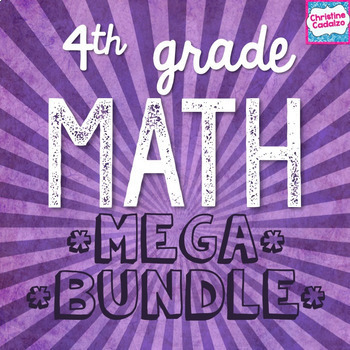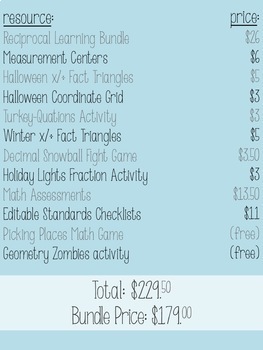Fourth Grade Math MEGA Bundle
- Zip
- Easel Activity
Products in this Bundle (32)
showing 1-5 of 32 products
Description
Includes ALL of my fourth grade Common Core math resources- math units, activities, games, assessments, and checklists.
**Purchasing this product will also give you access to any future fourth grade math products that I create- they will be added to this bundle as they are created. As more fourth grade math products are added, the price of the bundle will increase, but once you have purchased, you'll be able to download new products FREE FOR LIFE.**
Currently included are:
Complete Fourth Grade Math Units:
-Place Value & Base Ten: 4.NBT.1
-Multidigit Addition Unit: 4.NBT.4
-Multidigit Subtraction Math Unit: 4.NBT.4
-Equivalence and Comparing Fractions (with Obstacle Course!): 4.NF.1-2
-Adding and Subtracting Fractions (with Obstacle Course!): 4.NF.3
-Multiplying Fractions and Fraction Word Problems(with Obstacle Course!): 4.NF.4
-Tenths and Hundredths Fractions: 4.NF.5
-Introduction to Decimals and Converting Fractions to Decimals: 4.NF.6
-Introduction to Decimals and Converting Fractions to Decimals: 4.NF.7
-Perimeter and Area Formulas for Rectangles Unit: 4.MD.3
-Geometric Attributes: 4.G.1-2
Additional Teaching Materials:
-Reciprocal Learning Partner Pages (4th grade bundle) for computational fluency
-Measurement Centers (all MD standards)
-Printable Multiplication Array Cards
-Addition and Subtraction Puzzles
-Halloween Multiplication/ Division Fact Triangles
-Turkey-Quations Thanksgiving Math Activity
-Holiday Lights Fractions on a Number Line activities
-Winter Multiplication/ Division Fact Triangles
-Decimal Snowball Fight Math Game
Bonus Materials:
-Editable Common Core Standards Checklists
Free Products: (Included for your convenience!)
-various other free printables
This product is for use in ONE CLASSROOM ONLY. For additional teachers/ classes, please purchase extra licenses.
Starburst digital paper on cover by Tangstar Science
Christine Cadalzo
Copyright 2012-2023
All Rights Reserved.




